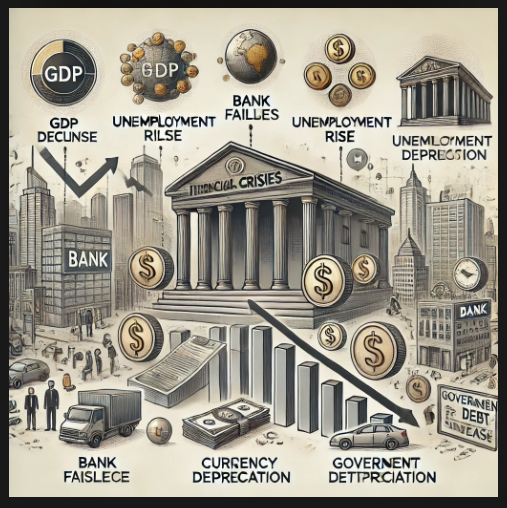Financial crises can have devastating consequences on a country's economy, leading to long-term structural changes and widespread socio-economic challenges. This article explores the causes, short-term and long-term effects, and real-world examples of financial crises to understand their impact on an economy.
1. Causes of Financial Crises
Financial crises arise due to various factors, including:
Banking Failures: Poor risk management, excessive lending, and financial mismanagement can lead to bank collapses (e.g., 2008 Global Financial Crisis).
Stock Market Crashes: Sharp declines in stock values reduce investor confidence and wealth (e.g., 1929 Great Depression).
Debt Crises: Excessive government or corporate borrowing can lead to defaults (e.g., Greek Debt Crisis 2010).
Currency Crises: A rapid depreciation of a nation's currency can trigger economic instability (e.g., Argentina 2001).
External Shocks: Wars, pandemics, or commodity price collapses can create financial turmoil (e.g., COVID-19 pandemic effects in 2020).
2. Short-Term Effects of Financial Crises
a) Economic Contraction & Recession
GDP declines due to reduced business activity and lower consumer spending.
Example: The 2008 Global Financial Crisis led to a 4.3% contraction in the U.S. economy in 2009.
b) Rising Unemployment
Companies lay off workers to cut costs, increasing joblessness.
Example: Spain's unemployment rate soared to 27% after the 2008 crisis.
c) Banking System Disruptions
Liquidity shortages cause banks to collapse or require bailouts.
Example: Lehman Brothers filed for bankruptcy in 2008, triggering a banking panic.
d) Currency Depreciation and Inflation
A weakened currency makes imports expensive, leading to inflation.
Example: Argentina faced hyperinflation after its 2001 economic crisis.
e) Decline in Consumer & Business Confidence
People and businesses spend less, further deepening the crisis.
Example: After the 2008 crisis, consumer spending in the U.S. fell by 3%.
3. Long-Term Effects of Financial Crises
a) Slow Economic Recovery & Low Growth
It takes years to recover from a crisis due to lost investments and debts.
Example: Greece’s economy shrank by 25% between 2008 and 2013 due to austerity measures.
b) Higher Government Debt
Governments borrow heavily to finance stimulus programs and bailouts.
Example: The U.S. national debt increased by over $9 trillion after the 2008 crisis.
c) Structural Economic Changes
Governments introduce stricter financial regulations and policies.
Example: The Dodd-Frank Act (2010) was introduced in the U.S. to prevent future crises.
d) Increased Social & Political Instability
Economic hardship can lead to protests and political upheaval.
Example: The Arab Spring (2010-2012) was partially fueled by economic grievances.
e) Impact on Global Trade
Global trade slows as demand falls worldwide.
Example: After the 2008 crisis, global trade declined by 9% in 2009.
4. Case Studies of Financial Crises
Case Study 1: The 2008 Global Financial Crisis
Cause: Subprime mortgage lending, excessive risk-taking by banks, and housing bubble burst.
Effects: Massive job losses, bank bailouts, global economic slowdown.
Recovery: Government stimulus packages and monetary policies (e.g., quantitative easing).
Case Study 2: The Asian Financial Crisis (1997-1998)
Cause: Excessive borrowing and currency devaluations in Thailand, Indonesia, and South Korea.
Effects: GDP contractions, unemployment surges, IMF bailouts.
Recovery: Structural reforms and economic restructuring by affected nations.
Case Study 3: The Greek Debt Crisis (2010-2018)
Cause: High government debt, weak economic growth, and eurozone financial instability.
Effects: Severe austerity measures, unemployment reaching 27%.
Recovery: EU and IMF bailouts with strict financial oversight.
5. Strategies to Mitigate the Impact of Financial Crises
a) Strong Financial Regulations
Implementing policies to prevent excessive risk-taking by banks.
b) Effective Monetary & Fiscal Policies
Central banks can lower interest rates and introduce stimulus packages to boost growth.
c) Diversification of Economy
Reducing reliance on a single industry prevents economic collapse during downturns.
d) Strengthening Social Safety Nets
Providing unemployment benefits and support programs to affected citizens.














0 Comments